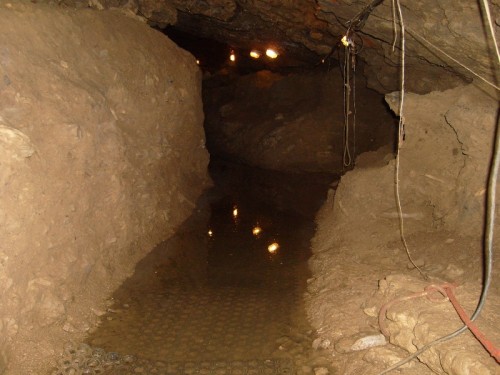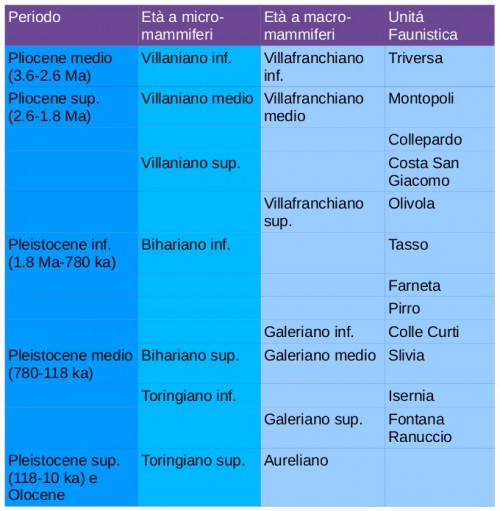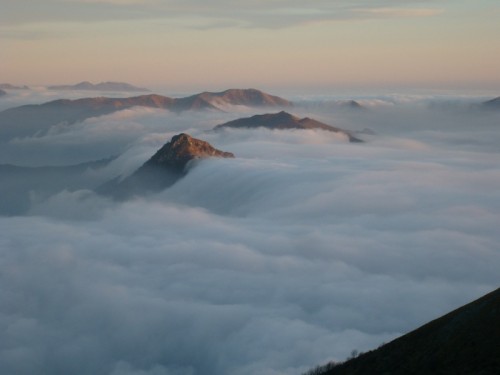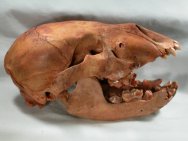Sono onorato di ospitare questo articolo di Davide Bertè, amico e collega di lunghe estati di lavoro.
L’argomento è tecnico e sarà un ottimo supporto per chi dovesse fare i conti con la datazione di alcune associazioni di mammiferi fossili italiani, ma sarà anche un ottimo spunto per chi è curioso e vuole rendersi un po’ conto di quanto siano complesse alcune tipologie di ricerca sul passato. Buona Lettura. (Stefano Rossignoli 22 novembre 2010).
Articolo di Davide Bertè – 22 novembre 2010
Capita spesso, durante uno scavo paleontologico, di rinvenire dei reperti ma di non poterli datare. Come fare allora per collocarli nel tempo geologico? L’unica soluzione è basarsi sui fossili presenti e vedere come sono associati. La biostratigrafia è quella branca che si occupa di determinare le suddivisioni del tempo geologico in base ai fossili che si rinvengono negli strati.
Sono in uso due scale: una basata sui macromammiferi e una sui micromammiferi. La distinzione è necessaria perché i due gruppi sono soggetti a diversi processi tafonomici (tutto ciò che capita a un organismo dopo la morte); inoltre, mentre i primi sono poco legati a condizioni microclimatiche e microambientali, i secondi invece lo sono molto.
Macromammiferi
Per quanto riguarda il Quaternario, dai 2.6 Ma fa a oggi, il periodo nel quale viviamo anche noi, sono state individuate tre etá a macromammiferi: il Villafranchiano, il Galeriano e l’Aureliano o Postgaleriano.
Le etá a mammiferi sono a loro volta suddivise in Unitá Faunistiche (UF) che sono un elenco di tutte le specie viventi in quel momento e che prendono il nome dal giacimento piú importante. Non sono da confondere con le faune locali, cioé l’elenco delle specie presenti in un determinato sito.
La prima Unitá Faunistica del Villafranchiano inferiore, quella di Tiversa, cade al di fuori dei limiti del Quaternario, e si colloca tra i 3.6 e i 2.6 Ma.
Il nuovo limite del Quaternario é stato posto 2.6 Ma fa, in corrispondenza dell’inversione paleomagnetica Gauss-Matuyama. Il Quaternario viene a sua volta suddiviso in Pleistocene e Olocene.
Il Villafranchiano medio include tre UF: Montopoli, Collepardo e Costa S.Giacomo. Il Villafranchiano superiore, il cui inizio é correlato con l’episodio paleomagnetico di Olduvai 1.8 Ma fa, è suddiviso in quattro UF: Olivola, Tasso, Farneta e Pirro.
Il Galeriano inferiore comincia con l’UF di Colle Curti circa 1.1 Ma fa in corrispondenza con l’episodio paleomagnetico di Jaramillo. Il Galeriano medio é composto dalle UF di Slivia e Isernia. Il Galeriano superiore include solo l’UF Fontana Ranuccio.
L’Aureliano, in genere, non viene suddiviso in UF in quanto comincia una forte regionalizzazione delle faune. È in questo periodo che compaiono le forme di mammiferi attuali.
Villafranchiano inferiore
UF di Triversa. Probabilmente sono rappresentati due momenti differenti, in quanto sono presenti sia animali di foresta umida sub-tropicale come Tapirus arvernensis, i mastodonti Anancus arvernensis e Mammut borsoni, il primate Mesopithecus monspessolanus, il cinghiale di piccola taglia Sus minor, Ursus minimus, etc. Sono poi presenti anche specie di prateria arborata quali l’antilope di grande taglia Leptobos stenometopon, il cervo di media taglia Pseudodama lyra, il rinoceronte Stephanorhinus elatus. Tra i carnivori ci sono il grande Homotherium crenatidens e il ghepardo Acinonyx pardinensis.
Villafranchiano medio
UF di Montopoli. La diffusione in questo periodo di taxa tipici di ambienti aperti come Gazella borbonica, il cavallo con un solo zoccolo Equus livenzovensis, il cervo di grossa taglia con i palchi a pettine Eucladoceros falconeri e l’elefante Mammuthus meridionalis gromovi, che sostituisce Anancus, indica il passaggio ad ambienti aperti. Carnivori presenti sono: Pachycrocuta brevirostris e Megantereon cultridens.
UF di Collepardo. Questa UF, correlata con quella di St. Vallier in Francia, vede la presenza di Leptobos stenometopon, giá presente a Triversa ma assente a Montopoli, l’elefante Mammuthus meridionalis, e sulle montagne Hemitragus.
UF di Costa San Giacomo. Simile alla precedente, sono di rilevante importanza la prima comparsa del cavallo Equus stenonis, del rinoceronte Stephanorhinus etruscus, il cinghiale di grossa taglia Sus strozzii e il piccolo lupo Canis etruscus, qui ancora sporadico ma molto diffuso nella successiva UF di Olivola. Qui sono presenti per l’ultima volta il mastodonte Anancus e il genere Gazella.
Villafranchiano superiore
UF Olivola. Testimonia una fase climatica temperato-fredda, con forte piovositá regionale. Il bovide più diffuso è l’antilope gregaria Leptobos etruscus, e tra i cervidi compaiono Eucladoceros dicranios-ctenoides e Pseudodam nestii, che non presenta palchi palmati come i veri daini. Tra i carnivori sono diffusi la iena Pachycrocuta brevirostris, che indica ambiente aperto, e Panthera gombaszoegensis.
UF Tasso. Fanno la loro prima comparsa Preovibos, che indica un ambiente aperto steppico, Leptobos vallisarni, con le cavicchie ossee portate sul frontale e con i fori oculari laterali, a indicare che viveva in ambienti aperti, l’esile Equus sthelini e Pseudodama eurygonus-farnetensis. Tra i carnivori va menzionata la prima comparsa del licaone Canis falconeri accanto alla forma sciacallina Canis arnensis e al piccolo lupo Canis etruscus.
UF Farneta. Simile per composizione alla precedente, si distingue per la comparsa dei megalocerini con Praemegaceros (Megaceroides) obscurus, e il rinoceronte Stephanorhinus hundsheimensis. Inoltre è presente l’elefante di grossa taglia Mammuthus meridionalis vestinus e il Cervalces gallicus.
UF Pirro. L’evento principale di questa UF è la comparsa del bisonte primitivo con le cavicchie ossee avanzate Bison (Eobison) degiulii, ma fa la sua prima comparsa anche Canis (Xenocyon) licaonides.
Galeriano inferiore
UF Colle Curti. Si assiste in questo periodo all’estinzione dellle specie villafranchiane, anche se alcune daranno origine a specie più adatte a climi freddi e aridi. Specie che segna l’inizio del Galeriano è Bison schoetensacki, che sostituisce Eobison e indica il passaggio ad un ambiente temperato-freddo. Altre prime comparse sono Praemegaceros (Megaceroides) verticornis, Elephas antiquus, Canis mosbachensis e Ursus deningeri.
Galeriano medio
UF Slivia. Le oscillazioni climatiche tra glaciali e interglaciali, che avvengono in questo periodo, influiscono notevolmente sulle faune e, in Italia, comincia a intravedersi la suddivisione tra l’area ligure-tirrenica, più secca, e quella adriatica più umida. Sono presenti in questo periodo numerose forme arcaiche di specie attuali: il capriolo Capreolus sussenbornensis, il cervo Cervus elaphus acoronatus, il daino Dama clactoniana, il rinoceronte di Merck Stephanorhinus kirchbergensis, la iena Crocuta spelaea e il leone Panthera leo fossilis.
UF Isernia. In questa UF sono rappresentati due momenti climatici distinti: una fase temperato fredda e una fase interglaciale più calda. I due momenti non sono distinti in quanto le datazioni non permettono di stabilire quale sia più recente e quale più antico. In ogni modo sono presenti: Megaceroides solhilacus, Hemitragus bonali, Elephas antiquus, Stephanorhinus hundsheimensis, Ursus deningeri e Panthera leo fossilis, Bos primigenius, Mammuthus trogontheri, Stephanorhinus hemitoecus, Cervus elaphus e Homotherium latidens, qui alla sua ultima comparsa.
Aureliano
In questo periodo si assiste all’estinzione di gran parte della megafauna, principalmente durante l’ultimo massimo glaciale. Durante l’Olocene poi, la diffusione dell’uomo ha alterato profondamente gli insiemi faunisici.
Vale la pena distinguere tra taxa freddi (Capra ibex, Marmota marmota primigenia, Alces alces, Cervalces carnutorum e Cervalces latifrons, Megaloceros giganteus, Bison bonasus, Bos primigenius, Mammuthus primigenius, Coelodonta antiquitatis, Ursus spelaeus, Canis lupus) e taxa caldi (Cervus elaphus, Capreolus capreolus, Dama dama, Sus scrofa).
Micromammiferi
Nel Quaternario sono individuate tre età a micromammiferi: Villaniano, Bihariano e Toringiano, e non sono suddivise in Unità Faunistiche.
Il Villaniano inferiore è caratterizzato dagli arvicolidi rizodonti (cioè con denti con radici) Villanyia e Borsodia e dall’associazione Mimomys hassiacus-Mimomys stehlini. Il Villaniano medio è caratterizzato dallla presenza di Mimomys polonicus e il Villaniano superiore dalle presenza di Mimomys pliocaenicus.
Il Bihariano inferiore è segnato dalla presenza della forma radicata Mimomys savini e dalla comparsa dei Microtus del sottogenere Allophaiomys arizodonti, che indicano la diffusione di un ambiente arido steppico, dominato da Graminacee che con le loro spicole silicee sono molto abrasive sullo smalto dei denti. Il Bihariano superiore è caratterizzato dall’associazione Microtus con Mimomys savini.
Il Toringiano inferiore è caratterizzato da Arvicola mosbachensis, un arvicolide dai molari con radici incipienti, che sarebbe una forma neotenica (cioè che mantiene i caratteri giovanili) della forma radicata Mimomys savini. Il Toringiano superiore, invece, è caratterizzato dall’associazione Microtus e Arvicola.
Davide Bertè 22 novembre 2010
Bibliografia:
Masini F., Sala B. 2007 Large and small mammal distribution patterns and
chronostratigraphic boundaries from the Late Pliocene to the Middle Pleistocene
of the Italian peninsula. Quaternary international, 160: 43-56.





buono per la preparazione all’esame di paleontologia dei vertebrati ed evoluzione dei vertebrati
Davvero! Davide qui ha fatto un lavoro utilissimo …e molto ricercato online!!!
Grazie Davide! e grazie Daniele per averci visitato. A presto …su scienzafacile!
Complimenti! Utilissimo !!!